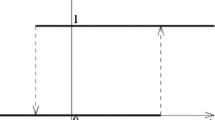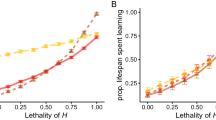Animals’ associative learning plays a crucial role in many intraspecific or interspecific interactions, involving an animal’s use of information on its interacting counterparts. Here, we present a theoretical model that captures the basic features of an animal’s associative learning, which may involve generalization, for a simplest case of warning signals. Specifically, we derive formulae for the average level of associative memory as functions of a few parameters that reflect the population density of prey, predator’s efficiency of prey detection, and the properties of predator’s associative learning, including generalization and memory decay. This average level of associative memory is of central importance in determining prey’s fitness and, thus, the evolution of warning signals (i.e. aposematism). The derived formula also shows that another species with similar signal enhances the fitness of an aposematic species of concern as long as their signal is similar enough for generalization to occur. The model developed here can be extended to more complicated cases and the basic idea can be applied to modeling other interactions involving associative learning with generalization.
Similar content being viewed by others
REFERENCES
Alatalo, R. V. & Mappes, J. (1996) Tracking the evolution of warning signals. Nature 382: 708--710.
Arak, A. & Enquist, M. (1993) Hidden preferences and the evolution of signals. Philosophical Transactions of the Royal Society of London B 349: 337--344.
Dukas, R. (1987) Foraging behavior of three bee species in a natural mimicry system: Female flowers which mimic male flowers in Ecballium elaterium (Cucurbitaceae). Oecologia 74: 256--263.
Endler, J. A. (1988) Frequency-dependent predation, crypsis and aposematic coloration. Philosophical Transactions of the Royal Society of London B 319: 505--523.
Engen, S., Järvi, T. & Wiklund, C. (1986) The evolution of aposematic coloration by individual selection: A life-span survival model. Oikos 46: 397--403.
Enquist, M. & Arak, A. (1993) Selection of exaggerated male traits by female aesthetic senses. Nature 361: 446--448.
Enquist, M. & Arak, A. (1994) Symmetry, beauty and evolution. Nature 361: 169--172.
Enquist, M. & Johnstone, R. A. (1997) Generalization and the evolution of symmetry preferences. Proceedings of the Royal Society of London B 264: 1345--1348.
Gamberale, G. & Tullberg, B. S. (1996) Evidence for a peak-shift in predator generalization among aposematic prey. Proceedings of the Royal Society of London B 263: 1329--1334.
Guilford, T. (1990) The evolution of aposematism. In: Insect Defenses (eds D. L. Evans & J. O. Schmidt) pp. 23--61. State University of New York Press, New York.
Hanson, H. M. (1959) Effects of discrimination training on stimulus generalization. Journal of Experimental Psychology 58: 321--334.
Heinrich, B. (1975) Bee flowers: A hypothesis on flower variety and blooming times. Evolution 29: 325--334.
Heinrich, B. (1979) ‘Majoring’ and ‘minoring’ by foraging bumblebees, Bombus vagans: An experimental analysis. Ecology 60: 245--255.
Johnstone, R. A. (1994) Female preference for symmetrical males as a by-product of selection for male recognition. Nature 361: 172--175.
Karlin, S. (1966) A First Course In Stochastic Processes. Academic Press, New York.
Leimar, O., Enquist, M. & Sillen-Tullberg, B. (1986) Evolutionary stability of aposematic coloration and prey unprofitability: A theoretical analysis. American Naturalist 128: 469--490.
Owen, R. E. & Owen, A. R. G. (1984) Mathematical paradigms for mimicry: recurrent sampling. Journal of Theoretical Biology 109: 217--247.
Real, L. A. (1981) Uncertainty and pollinator--plant interactions: The foraging behavior of bees and wasps on artificial flowers. Ecology 62: 20--26.
Ryan, M. J. (1997) Sexual selection and mate choice. In: Behavioural Ecology: An Evolutionary Approach, 4th ed. (eds J. R. Krebs & N. B. Davies) pp. 179--202. Blackwell Science, Oxford.
Schuler, W. & Roper, T. J. (1992) Responses to warning coloration in avian predators. Advances in Study Behavior 21: 111--146.
Staddon, J. E. R. (1975) A note on the evolutionary significance of ‘supernormal’ stimuli. American Naturalist 109: 541--544.
Stiles, E. W. (1992) Animals as seed dispersers. In: Seeds: The Ecology of Regeneration in Plant Communities (ed. M. Fenner) pp. 87--104. CAB, Oxford.
Turner, J. R. G., Kearney, E. P. & Exton, L. S. (1984) Mimicry and the Monte Carlo predator: The palatability spectrum and the origins of mimicry. Biological Journal of Linnean Society 23: 247--268.
Turner, J. R. G. & Speed, M. P. (1996) Learning and memory in mimicry. I. Simulations of laboratory experiments. Philosophical Transactions of the Royal Society of London B 351: 1157--1170.
Yachi, S. & Higashi, M. (1998) The evolution of warning signals. Nature 394: 882--884.
Author information
Authors and Affiliations
Corresponding author
About this article
Cite this article
Yachi, S., Higashi, M. Modeling associative learning with generalization for a case of warning signals. Ecol Res 14, 243–248 (1999). https://doi.org/10.1046/j.1440-1703.1999.143299.x
Received:
Accepted:
Issue Date:
DOI: https://doi.org/10.1046/j.1440-1703.1999.143299.x




